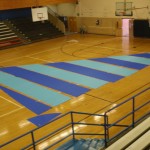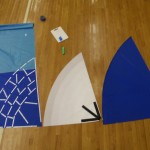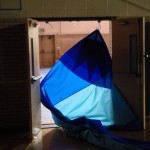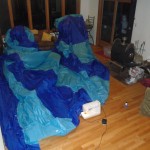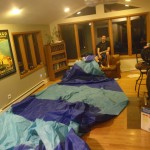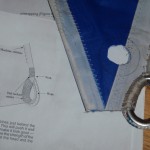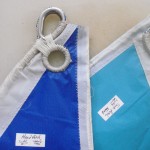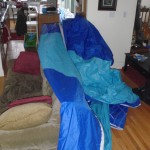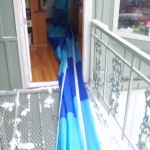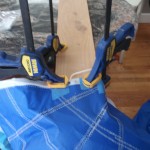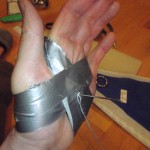Feb 06
Sail update: Finished (back in December)
Finally. 10 months after it started, the sail is finished. It was supposed to be done by June. Then…. that didn’t quite happen. And so it got put off. And put off. And put off. And soon, the boat was threatening to leave! So I doubled down over Thanksgiving break and brought the thought of the completion of the sail into the ballpark.
Those first days of sewing in the gym were fun. Huge panels getting sewn together and enormous visible progress of work. It was fun back then! But at Thanksgiving, I was no longer in a large gymnasium. I was squashed into the smallish living room of a house. The sail’s luff was three times the length of the room. At one point, I felt it absolutely necessary to stretch out the luff of the sail. It went through the living room, through the kitchen, over the island countertop, out the door to a deck off the kitchen and to the other side of deck railing where I anchored it so that I could stretch it taught. There was snow out on the deck. It felt ridiculous.
I was stretching the luff line of the sail to try and see by how much I had to chop off the top of our sail. The luff line, which came with the sail-making kit from Sailrite is made of T900 from New England Ropes, requires two double braid eyesplices, one at each end, to attach the sail at it’s head to the mast, and at it’s tack to the bow of the boat. After making the first eyesplice, I then,carefully measured the T900 line to the exact measure ment of our luff, (48’9”) and marked that point as where the other eye-splice should end. I then remeasured it as I’ve had trouble measuring things in the past.
With the second eyesplice made I tried as best I could in a 18′ wide room to see how well the luff line matched up to the length of the luff of the sail. And everytime, it seemed to come up short. And then I remembered that when making the second eye splice the rope will bunch up, thicken and consequently shorten. This happens because the eyesplice is designed to have the rope double back on itself. The core of the rope, after going around the eye, goes back inside itself. It’s a very cool thing and it locks itself into place. I highly recommend making them simply because they are so cool. At any rate, I had to chop off about 2 inches from the head of the sail and short both ends just a smidge so that the luff line would be better aligned. Such are the trials and tribulations of a first time sail maker.
A week after Thanksgiving, I took two days off from work during a major push where I was determined to get 30 hours of work done on the sail. Sorry boss, priorities. One half of one of these days was spent trying to figure out how to install the cleats for the leech line and the foot line. My first issue was with the rivot/grommet thing they sent me. Home Depot was baffled as to what tool should be used to both A: cut a hole through the 9 layers of fabric where the cleats were to be installed, and B: how to press home the rivot/grommet. Finally a leather store, Tandy Leather Factory, came through for me with a suggestion, while I was there buying a sewing palm. I Suffice to say I ended up using a cordless drill to make the holes in the sail, at very low RPM and with clamps within milimeters of where the drill bit was. All of this was conducted in the kitchen. See pictures. I was at Tandy after suffering through a day of using a makeshift palm out of duct tape and a tiny plastic cup. Tandy wasn’t open on Sunday and I had work to do, so makeshift palm it was.
Within that time, though, there came a moment of celebration when I could finally put the sewing machine away and move on to hand sewing. My roommates were also happy that I didn’t have to rearrange all of the living room furniture every time I wanted to work on the sail. To begin the hand sewing, I first installed metal rings next to the head and tack of the sail. Then there was anchoring those to the edges. Then there was sewing the leather patches on. When sewing the leather patches (this was done in California after driving out there over my winter break with an unfinished sail in the back seat), I began attaching the sewing palm to a leg of a chair turned upside down so I could then more effectively use both hands and all my weight as leverage to drive the needle through 5 layers of 1.5 oz ripstop nylon, 5 layers of 4 oz dacron, and if it was near the edge of the sail, another two layers of the 5 oz Dacron tape folded around the sail edge. By my count that’s 37.5 ounces of fabric to push through. That means something, I’m not sure what though. No easy task is what it meant to me. I had to simultaneously hold the needle so that it wouldn’t flex and bend and hold the fabric around the needle and hold the chair with the palm attached to it with my feet so that it wouldn’t slide away and make sure I didn’t stab myself. I’m impressed I didn’t draw blood more than twice.
It’s finished though and I have an enormous sense of exhaustion, elation and pride. This was the largest boat project I got to be a part of, and it was pretty much all on me. No help, no other expertise from the other guys. It felt good to be the sole expert. At one point, Matt said, “You better finish it, ’cause I sure as hell have no clue how to.” Well I finished it, even if I stretched it out until December 28th.
After finally finishing and toasting, with a much deserved beer, the official hand-over ceremony of the sail to Matt, Matt began playing with the scraps of sail left over for repairs if that might ever be necessary. Karen, please make sure you’ve made him some better shorts by the time I get out there. Because if I ever see him in just the sail cloth like he was showing off, I think I might be permanently scarred.
I was back out in San Francisco helping with a big last minute push on getting work done. And giving Karen and Matt, and me in particular a big morale boost. There was mention of going sailing to see the sail get flown. Given the state of the boat, I knew that wasn’t really a possibility. But we did end up hoisting my sail in the marina just to see how it looked, and to cut some drifter sheet lines for it. It looked beautiful. I felt proud. I also felt embarrassed that I left on highly visible small stickers identifying each panel. I think Karen took some pictures. If so, I hope she posts them. I was too busy just looking at it, thinking about how long it had taken, and how much has happened in my life since I started it. A ten month sailboat project was right there flapping lightly in the breeze. The last ten month saga of my life was there, playing lightly in my mind.
I’m envious that I won’t get to be there when it is first flown. But I looking forward to joining the boat in June and being there as long as my money can sustain me. We’re not exactly sure where the boat will be. I’m committed as I can be to being there. And finally getting to use the boat, instead of just talking about it. Looking forward to it.
